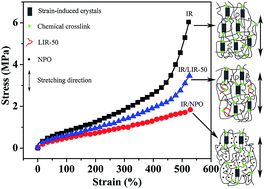Effects of plasticizers on the strain-induced crystallization and mechanical properties of natural rubber and synthetic polyisoprene
Abstract
Effects of liquid isoprene (LIR-50) and naphthenic oil (NPO) on the strain-induced crystallization (SIC) measured by in situ synchrotron wide-angle X-ray diffraction (WAXD) and mechanical properties of vulcanized natural rubber (NR) and synthetic polyisoprene (IR) were studied. The onset strain (αc) of SIC of NR and IR was 250% and 350%, respectively. NR and IR exhibited stress upturns at strain 383% and 450% in stress–strain curves, and the crystallinities of NR and IR were 7.6% and 8.6%, respectively. After vulcanization, LIR-50 became part of the rubber network, while NPO still existed as free small molecules in rubber networks. After the respective addition of LIR-50 and NPO, the αc of NR composites rarely changed, while the αc of IR composites increased. In addition, the crystallinity and tensile strength of NR and IR filled with LIR-50 and NPO, respectively, decreased, and the reduction in IR composites was higher than that in NR composites. The crystallinity and mechanical properties of the NR and IR plasticized by LIR-50, respectively, were higher than those plasticized by NPO. The maintenance of high crystallinity of NR or IR composites may ensure their good mechanical properties. Therefore, LIR-50 can be used as a reactive plasticizer to maintain good mechanical properties for NR and IR.



 Please wait while we load your content...
Please wait while we load your content...